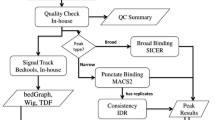Abstract
Proximity ligation-assisted ChIP-Seq (PLAC-Seq), also known as HiChIP, is a method to detect and quantify chromatin contacts anchored at genomic regions bound by specific proteins or histone modifications. By combining in situ Hi-C and chromatin immunoprecipitation (ChIP) using antibodies against transcription factors (TFs) or histone marks of interest, the method achieves targeted interrogation of chromatin organization at a subset of genomic regions. PLAC-Seq is able to identify long-range chromatin interactions at kilobase-scale resolution with significantly reduced sequencing cost.
Access this chapter
Tax calculation will be finalised at checkout
Purchases are for personal use only
Similar content being viewed by others
References
Dekker J, Rippe K, Dekker M, Kleckner N (2002) Capturing chromosome conformation. Science 295:1306–1311. https://doi.org/10.1126/science.1067799
Dekker J, Marti-Renom MA, Mirny LA (2013) Exploring the three-dimensional organization of genomes: interpreting chromatin interaction data. Nat Rev Genet 14:390–403. https://doi.org/10.1038/nrg3454
Denker A, de Laat W (2016) The second decade of 3C technologies: detailed insights into nuclear organization. Genes Dev 30:1357–1382. https://doi.org/10.1101/gad.281964.116
Schmitt AD, Hu M, Ren B (2016) Genome-wide map** and analysis of chromosome architecture. Nat Rev Mol Cell Biol 17(12):743–755. https://doi.org/10.1038/nrm.2016.104
Lieberman-Aiden E, van Berkum NL, Williams L et al (2009) Comprehensive map** of long-range interactions reveals folding principles of the human genome. Science 326:289–293. https://doi.org/10.1126/science.1181369
Rao SSP, Huntley MH, Durand NC et al (2014) A 3D map of the human genome at kilobase resolution reveals principles of chromatin loo**. Cell 159:1665–1680. https://doi.org/10.1016/j.cell.2014.11.021
Fullwood MJ, Liu MH, Pan YF et al (2009) An oestrogen-receptor-alpha-bound human chromatin interactome. Nature 462:58–64. https://doi.org/10.1038/nature08497
Dryden NH, Broome LR, Dudbridge F et al (2014) Unbiased analysis of potential targets of breast cancer susceptibility loci by Capture Hi-C. Genome Res 24:1854–1868. https://doi.org/10.1101/gr.175034.114
Hughes JR, Roberts N, McGowan S et al (2014) Analysis of hundreds of cis-regulatory landscapes at high resolution in a single, high-throughput experiment. Nat Genet 46:205–212. https://doi.org/10.1038/ng.2871
Mumbach MR, Rubin AJ, Flynn RA et al (2016) HiChIP: efficient and sensitive analysis of protein-directed genome architecture. Nat Methods 13:919–922. https://doi.org/10.1038/nmeth.3999
Fang R, Yu M, Li G et al (2016) Map** of long-range chromatin interactions by proximity ligation-assisted ChIP-seq. Cell Res 26:1345–1348. https://doi.org/10.1038/cr.2016.137
Juric I, Yu M, Abnousi A et al (2019) MAPS: Model-based analysis of long-range chromatin interactions from PLAC-seq and HiChIP experiments. PLoS Comput Biol 15:e1006982. https://doi.org/10.1371/journal.pcbi.1006982
Landt SG, Marinov GK, Kundaje A et al (2012) ChIP-seq guidelines and practices of the ENCODE and modENCODE consortia. Genome Res 22:1813–1831. https://doi.org/10.1101/gr.136184.111
Acknowledgments
This work is supported by U54 DK107977 to B.R.
Author information
Authors and Affiliations
Corresponding author
Editor information
Editors and Affiliations
Rights and permissions
Copyright information
© 2021 The Author(s), under exclusive license to Springer Science+Business Media, LLC, part of Springer Nature
About this protocol
Cite this protocol
Yu, M., Juric, I., Abnousi, A., Hu, M., Ren, B. (2021). Proximity Ligation-Assisted ChIP-Seq (PLAC-Seq). In: Borggrefe, T., Giaimo, B.D. (eds) Enhancers and Promoters. Methods in Molecular Biology, vol 2351. Humana, New York, NY. https://doi.org/10.1007/978-1-0716-1597-3_10
Download citation
DOI: https://doi.org/10.1007/978-1-0716-1597-3_10
Published:
Publisher Name: Humana, New York, NY
Print ISBN: 978-1-0716-1596-6
Online ISBN: 978-1-0716-1597-3
eBook Packages: Springer Protocols




